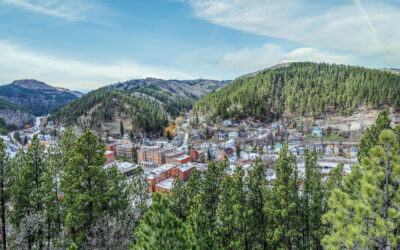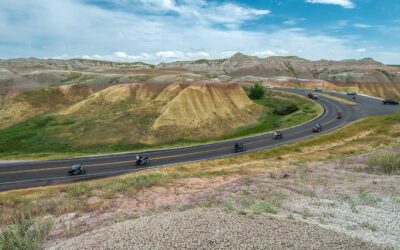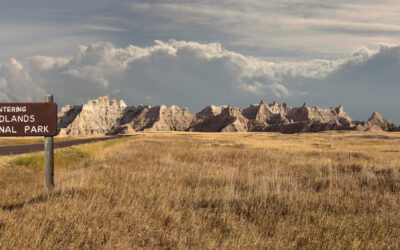South Dakota, a land of boundless skies and diverse landscapes, offers photographers a canvas of natural wonder. From the rugged Badlands to the iconic Mount Rushmore, the state presents a plethora of opportunities for capturing breathtaking images. Whether you’re drawn to wildlife, historical monuments, or the sheer beauty of nature, South Dakota’s ‘Land of Infinite Variety’ does not disappoint. This article explores the top photography spots in South Dakota, each offering unique vistas and experiences for shutterbugs.
Key Takeaways
- South Dakota’s rolling prairies and status as the ‘Pheasant Capital of the World’ provide unique opportunities for wildlife photography, especially during the autumn season.
- The Badlands National Park presents dramatic landscapes and the chance to capture the untamed wildlife, with sunrise and sunset offering magical lighting conditions.
- Mount Rushmore and the Black Hills offer iconic and mystical photography settings, with seasonal changes offering a variety of splendid backdrops.
- Sylvan Lake is the perfect spot for capturing serene water reflections and woodland scenes, with trails that offer photographers a chance to find their unique vantage point.
- The Great Plains offer expansive vistas and the ability to tell stories through landscape and weather photography, including the dramatic scenes of storm chasing.
The Pheasant Photographer’s Paradise
The Rolling Prairies of South Dakota
South Dakota’s prairies are a testament to the state’s title as the ‘Pheasant Capital of the World‘. As autumn arrives, the landscape transforms into a vibrant tapestry of colors, setting the stage for wildlife and nature photographers alike. The prairie grasslands become alive with the sounds of rustling cornstalks and the calls of waterfowl, creating a natural symphony that’s as photogenic as it is enchanting.
Photographers seeking to capture the essence of South Dakota’s rolling prairies will find no shortage of subjects. From the golden hues of the grasses to the dynamic skies that preside over them, the prairies offer a multitude of opportunities for stunning landscape shots. It’s not just about the scenery; the wildlife here, particularly the rooster pheasant, provides action-packed moments for those quick enough to capture their flight.
When planning a photography trip to these prairies, consider these tips:
- Visit during the golden hours of sunrise and sunset for the best light.
- Be patient and ready; wildlife moments happen swiftly.
- Explore different vantage points to add variety to your shots.
Remember, the prairies are not just a backdrop for photography; they’re an active participant in the story of the wild, the allure of open fields, and the robust game populations that call this land home.
Capturing the Flight of the Rooster Pheasant
In the heart of the Midwest, South Dakota reigns as the premier destination for pheasant photography. The state’s vast prairies serve as a natural stage where the rooster pheasant, with its vibrant plumage and swift flight, plays the leading role. Timing is crucial; the golden hours of dawn and dusk offer the soft, diffused light that can turn a good photo into a great one.
To capture the essence of these elusive birds, photographers must blend patience with anticipation. Positioning is key, and understanding the pheasant’s behavior can lead to that perfect shot. Here’s a quick guide to help you get started:
- Scout the area: Familiarize yourself with the terrain and find common pheasant pathways.
- Stay concealed: Use natural cover or a blind to avoid spooking the birds.
- Be patient: Wait for the right moment when the bird is in full display or taking flight.
- Use the right gear: A telephoto lens and a fast shutter speed are essential to freeze the action.
South Dakota offers diverse hunting and fishing lodges in various regions like Highmore, Kimball, Frederick, Fedora, Wessington, Keldron, Selby, Rosholt, Platte, and Lake Andes. Explore the unique experiences in Western, Central, and Eastern South Dakota to find your perfect photography adventure.
Autumn’s Golden Hues: A Backdrop for Wildlife Photography
As the South Dakota landscape transforms with the arrival of autumn, photographers are presented with a palette of golden hues that create a stunning backdrop for wildlife photography. The cooler temperatures and shorter days signal a flurry of activity among the local fauna, offering ample opportunities to capture the essence of the season.
The golden light of autumn is not just a visual treat; it’s a photographer’s ally. It casts a warm glow that enhances the natural colors of the landscape and wildlife, providing a soft, diffused light that is perfect for photography. Timing is crucial, as the light changes rapidly, and the best shots are often found during the golden hours of early morning and late afternoon.
To make the most of the autumn season in South Dakota, consider these tips:
- Scout locations in advance to find the best spots for wildlife sightings.
- Pay attention to weather patterns, as they can dramatically alter the lighting and mood of your photographs.
- Be patient and respectful of wildlife; use a long lens to capture intimate moments without disturbing the animals.
Whether you’re aiming to photograph the majestic flight of a rooster pheasant or the serene movements of deer through the amber fields, autumn in South Dakota is a time when every frame tells a story of change and preparation for the winter ahead.
Badlands: A Rugged Canvas for the Adventurous Lens
The Dramatic Landscapes of the Badlands
The Badlands of South Dakota present a striking tableau of eroded buttes, pinnacles, and spires that defy the imagination. This rugged terrain, sculpted by water and wind over millions of years, offers photographers a canvas of contrasting colors and textures. The interplay of light and shadow across these formations creates a dynamic environment for photography, especially during the golden hours of dawn and dusk.
The park’s geological features are not only visually arresting but also rich in history. Layers of sedimentary rock tell a story of ancient ecosystems, with fossils that reveal the area’s prehistoric life. Photographers can capture the essence of time itself within their frames, juxtaposing the ancient earth against the ever-changing sky.
For those seeking to document the diverse landscapes of the Badlands, here are some must-visit spots:
- Pinnacles Overlook: Ideal for panoramic shots
- Yellow Mounds Overlook: Captures the park’s striking color palette
- Saddle Pass Trail: Offers unique vantage points
Remember, the Badlands are not just a feast for the eyes but an epic adventure for the soul. Whether you’re capturing bison, exploring prairie dog towns, or waiting for that perfect sunset, the park’s vastness and raw beauty are sure to leave a lasting impression.
Sunrise and Sunset: The Magic Hours for Photographers
The Badlands of South Dakota offer a dramatic and ever-changing landscape that is particularly captivating during the golden hours of sunrise and sunset. The interplay of light and shadow during these times accentuates the rugged textures and layered formations, creating a photographer’s dream scene. To make the most of these magic hours, it’s essential to plan ahead and be prepared for the fleeting moments of perfect lighting.
- Scout your location the day before to find the best vantage points.
- Check the weather forecast to anticipate the conditions you’ll be working with.
- Set up your equipment early so you’re ready to capture the changing light.
- Experiment with settings to best capture the dynamic range of colors.
Remember, the best time to photograph the Badlands is during the two hours around sunrise and sunset, when the sun is low and the sky is painted with a spectrum of warm colors. This is when the landscape truly comes alive, offering a multitude of photographic opportunities that change minute by minute.
Wildlife in the Wilderness: Snapshots of the Untamed
South Dakota’s wilderness is a treasure trove for photographers seeking to capture the essence of untamed wildlife in their natural habitat. The Badlands National Park, in particular, is a sanctuary for bighorn sheep, prairie dogs, and the elusive swift fox. These creatures, along with the majestic bison and pronghorn antelope, provide a dynamic subject matter for wildlife photography.
The key to successful wildlife photography here is patience and respect for the animals’ space. Early morning or late afternoon are prime times for activity, offering the best natural lighting conditions. Photographers should be prepared for the elements and ready to adapt to the unpredictable movements of wildlife.
To maximize your chances of capturing that perfect shot, consider these tips:
- Scout the area: Familiarize yourself with the terrain and wildlife patterns.
- Stay silent and unobtrusive: Move slowly and quietly to avoid startling the animals.
- Use the right gear: A telephoto lens is essential for close-ups while maintaining a safe distance.
- Be patient: Wildlife photography is a waiting game; the perfect shot could take time.
Remember, the goal is to document the beauty of these creatures without disturbing their natural behaviors. With the right approach, South Dakota’s wilderness will reward you with stunning, authentic snapshots of the untamed.
Mount Rushmore: Framing the Faces of History
Iconic Perspectives: Unique Angles of Mount Rushmore
Mount Rushmore, known for its colossal carved faces of four U.S. presidents, offers more than just the traditional frontal viewpoint. Photographers seeking to capture this monumental sculpture in a new light can explore various vantage points for a fresh perspective.
For instance, the Presidential Trail provides a closer look at the granite features, while the lesser-known Old Baldy Trail gifts adventurers with a distant, yet encompassing view. Here’s a quick guide to some of the unique angles you can shoot from:
- Presidential Trail: Up-close details of the sculpture.
- Old Baldy Trail: A full view set against the Black Hills.
- Sculptor’s Studio: Insights into the creation process, with original tools on display.
- Norbeck Overlook: A wide-angle scene that captures the surrounding landscape.
Timing is crucial when photographing Mount Rushmore. The play of light and shadow can dramatically alter the mood and depth of your images. Early morning light casts a warm glow on the faces, while late afternoon brings out the texture and contours. Remember, the best shot is not always the most obvious one; sometimes, it’s about finding that unique angle that tells a story in a way words cannot.
The Black Hills’ Mystique in Photography
The Black Hills of South Dakota, cloaked in a shroud of ponderosa pines and granite peaks, offer photographers a canvas of contrasts. The region’s natural beauty is a magnet for those seeking to capture the essence of the Midwest’s wild landscapes. From the snow-capped peaks in winter to the vibrant greens of summer, the Black Hills change with the seasons, each offering a unique perspective for the lens.
The area’s historical allure is palpable, with towns like Deadwood echoing tales of the gold rush era. Photographers find inspiration in the blend of the old and the new, where modern-day explorers tread paths once walked by legends of the frontier. The Black Hills’ mystique is not just in its landscapes but also in the stories they tell.
To truly grasp the photographic potential of the Black Hills, consider these points:
- The interplay of light and shadow in the forested areas can create dramatic effects.
- Historical structures provide a sense of place and time, adding depth to your images.
- Wildlife, though sometimes elusive, offers moments of surprise and splendor.
Whether you’re a seasoned photographer or an amateur with a keen eye, the Black Hills beckon with their untamed beauty and historical whispers. It’s a place where every shot tells a story, and every visit uncovers a new secret to be captured.
Seasonal Splendor: When to Visit for the Best Shots
Mount Rushmore’s grandeur is a year-round attraction, but each season offers a unique palette for photographers. Spring brings a rebirth of color as the surrounding Black Hills begin to bloom, creating a vibrant contrast against the granite faces. Summer boasts clear skies and longer days, perfect for capturing the monument in different lights, and if you time your visit right, you can witness a stunning 4th of July fireworks display.
The fall season is a spectacle of color, with the deciduous trees painting a fiery backdrop for the stoic presidents. Winter, while challenging, can reward the persistent photographer with a pristine snow-covered landscape, offering a serene and contrasting composition. For those seeking a comprehensive experience, consider exploring nearby attractions like Jewel Cave, Badlands National Park, and the historic towns sprinkled throughout the region.
To maximize your photographic journey through South Dakota, here’s a quick seasonal guide:
- Spring: Wildflowers and budding trees
- Summer: Vivid blue skies and the 4th of July event
- Fall: Autumn foliage and softer light
- Winter: Snowy scenes and fewer tourists
Each season not only transforms Mount Rushmore but also offers distinct experiences in different regions of South Dakota. Whether you’re chasing the golden hour or the tranquility of a winter morning, planning your visit around these seasonal highlights will ensure you capture the essence of this monumental landmark.
The Serenity of Sylvan Lake: Water Reflections and Woodland Trails
Mirror-like Waters: Perfect Reflections at Sylvan Lake
Sylvan Lake, often referred to as the ‘crown jewel‘ of Custer State Park, offers photographers a tranquil setting to capture stunning reflections. The early morning light bathes the landscape in a soft glow, creating a mirror-like effect on the lake’s glassy surface. This natural phenomenon provides a unique opportunity for photographers to create symmetrical compositions, juxtaposing the rugged rock formations against the placid water.
When planning your visit, consider these tips for the best photographic experience:
- Arrive early to catch the serene atmosphere and gentle light of dawn.
- Use a tripod to ensure sharp images, especially in the soft light of early morning or late afternoon.
- Experiment with different perspectives; get close to the water’s edge or find a higher vantage point for a panoramic view.
Remember, the key to capturing the essence of Sylvan Lake lies in patience and observation. Take the time to explore the area, and you’ll find that each angle offers a new perspective, each hour of the day casts a different light, and every season brings its own unique beauty.
The Harmony of Nature: Capturing Flora and Fauna
South Dakota’s Sylvan Lake offers photographers a unique opportunity to delve into the harmony of nature, capturing the intricate dance of flora and fauna through their lenses. The area’s biodiversity is a treasure trove for shutterbugs, with each season bringing its own palette and cast of characters to the frame.
The region’s flora ranges from the delicate wildflowers that dot the landscape to the towering pines that stand as silent sentinels of the forest. Wildlife photographers will find themselves spoilt for choice, with the chance to photograph everything from chipmunks scurrying along the forest floor to majestic elk grazing in the meadows.
To maximize your photographic journey, consider these tips:
- Early morning and late afternoon are prime times for capturing the soft, diffused light that accentuates the natural beauty of the area.
- Patience is key; wildlife photography often requires waiting for the perfect moment when an animal graces the scene.
- Explore different perspectives; sometimes, the most captivating images are found by looking at subjects from a new angle.
Remember, the goal is to capture the essence of Sylvan Lake’s natural environment, creating images that resonate with the viewer and reflect the serene beauty of this South Dakota gem.
Hiking for the Perfect Shot: Sylvan Lake’s Scenic Trails
Sylvan Lake, nestled within the Black Hills of South Dakota, is a photographer’s haven, offering a blend of tranquil waters and lush woodlands. The trails around Sylvan Lake provide a natural gallery for photographers seeking to capture the essence of South Dakota’s serene landscapes. Each path offers a unique vantage point, from the whispering pines to the lake’s mirror-like surface reflecting the sky’s ever-changing palette.
For those ready to lace up their hiking boots, here’s a quick guide to the trails:
- Sunday Gulch Trail: A challenging route with rewarding views.
- Trail #9 to Harney Peak: A strenuous hike leading to the highest point in South Dakota.
- Sylvan Lake Shore Trail: An easy loop perfect for families and casual photographers.
Remember, the journey is as important as the destination. Take your time to explore and let the natural beauty inspire your photography. And for those looking to stay updated on the latest and greatest spots for outdoor photography, consider joining our newsletter. South Dakota offers diverse attractions like hiking trails, state parks, and unique regions. Stay informed about all the happenings in the state.
The Great Plains Reimagined: Vistas and Vignettes
The Expansive Vistas of South Dakota’s Great Plains
The Great Plains of South Dakota offer a vast canvas for photographers, where the horizon stretches endlessly and the sky meets the earth in a seamless embrace. The allure of open fields and robust game populations makes it a haven for wildlife photographers, especially those seeking to capture the essence of the ‘Pheasant Capital of the World’.
As the autumn winds sweep across the prairies, the landscape transforms into a golden sea, providing a stunning backdrop for the ever-elusive rooster pheasant. The state’s reputation for abundant wildlife is not just a claim; it’s a photographer’s reality, with opportunities to snap the flight of birds of prey that concentrate here during the colder months.
For those who venture into this wilderness, the experience is more than just a hunt for the perfect shot; it’s an odyssey into the heart of America’s frontier. The Great Plains reimagined through the lens offer a unique storytelling opportunity, where each photo narrates a tale of life on the plains. Here’s a quick guide to making the most of your photographic journey:
- Scout for locations where birds of prey are known to congregate.
- Time your visits to capture the dynamic changes in light and shadow.
- Embrace the elements, as changing weather can add drama to your shots.
- Be patient and persistent, as wildlife photography is often a waiting game.
Whether you’re a seasoned photographer or an enthusiast, South Dakota’s Great Plains are a testament to the state’s moniker as a land of infinite variety. It’s a place where each visit can yield a different perspective, a new story, and an unforgettable image.
Storytelling through the Lens: Life on the Plains
The Great Plains of South Dakota offer a canvas as vast and varied as the stories they hold. Photographers find a unique narrative in every frame, capturing the essence of life on the plains. From the daily routines of local farmers to the untamed spirit of the wildlife, each snapshot tells a part of the region’s tale.
The art of storytelling through photography requires an eye for detail and a sense of connection to the subject. Here are a few tips to bring the stories of the plains to life:
- Seek out the human element. Whether it’s a rancher at work or a child playing in the fields, people provide a relatable context to your images.
- Pay attention to the environment. The vast skies, rolling hills, and changing seasons can all serve as powerful backdrops for your narrative.
- Capture the action. A flock of birds taking flight or a tractor plowing the fields adds dynamism to your photos.
Remember, the key to compelling storytelling is authenticity. Let the natural wonders and the daily life of the plains guide your lens, and you’ll find that the stories will unfold before you.
Chasing Storms: Dramatic Weather Photography
South Dakota’s Great Plains offer a unique opportunity for photographers to capture the raw power of nature through storm chasing. The pursuit of storm photography requires preparation, patience, and a respect for the weather’s unpredictability. Safety should always be the top priority, and it’s essential to stay informed with the latest weather forecasts and apps.
When planning a storm photography expedition, consider these tips:
- Monitor weather reports and radar apps to identify potential storm development.
- Equip your camera gear with protective housing to shield it from rain and debris.
- Keep a safe distance from severe weather phenomena like tornadoes or lightning.
- Use a tripod for stability and to capture long-exposure shots that emphasize the storm’s movement.
The Great Plains’ expansive skies serve as a dramatic backdrop for storm photography, with each season bringing its own challenges and rewards. Spring and summer are peak times for thunderstorm activity, offering dynamic cloud formations and lightning displays. Meanwhile, the cooler months can surprise with sudden snowstorms, creating serene white landscapes. Regardless of the season, the key to successful storm photography lies in an adventurous spirit and a keen eye for the moments when nature reveals its most spectacular scenes.






